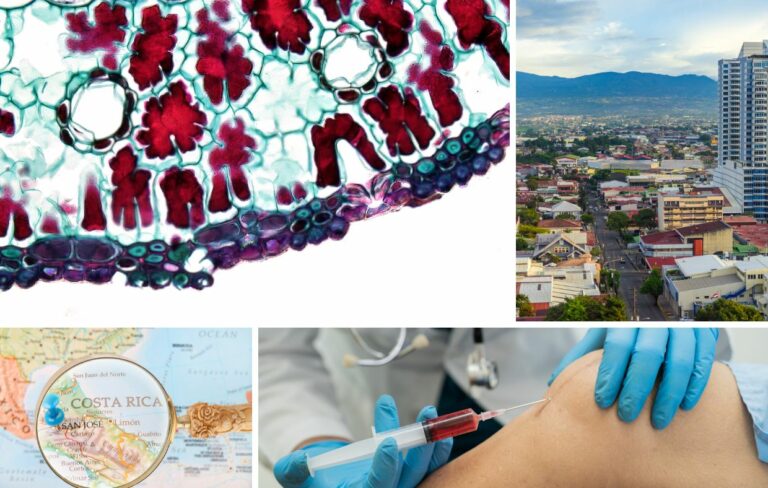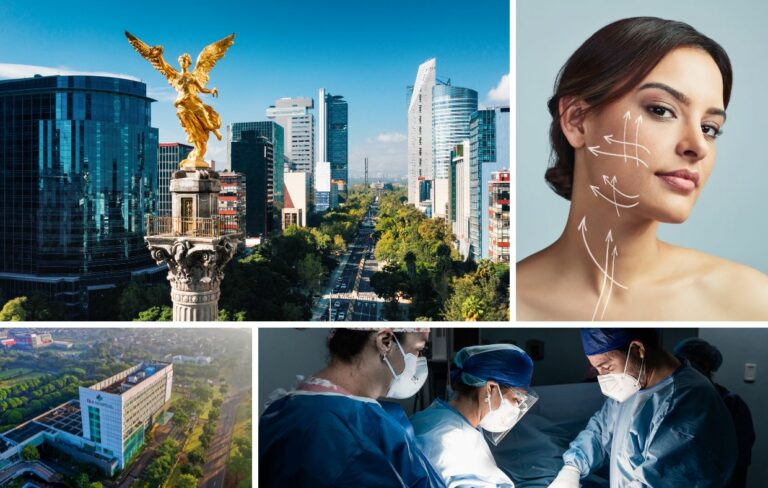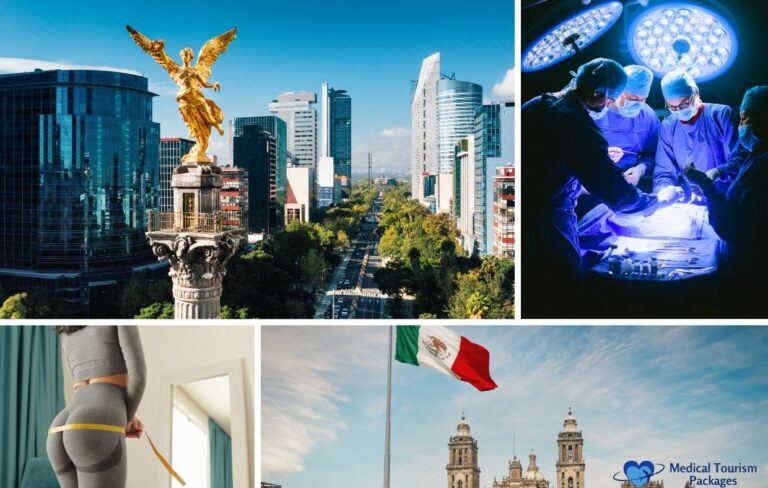Book Appointment Now
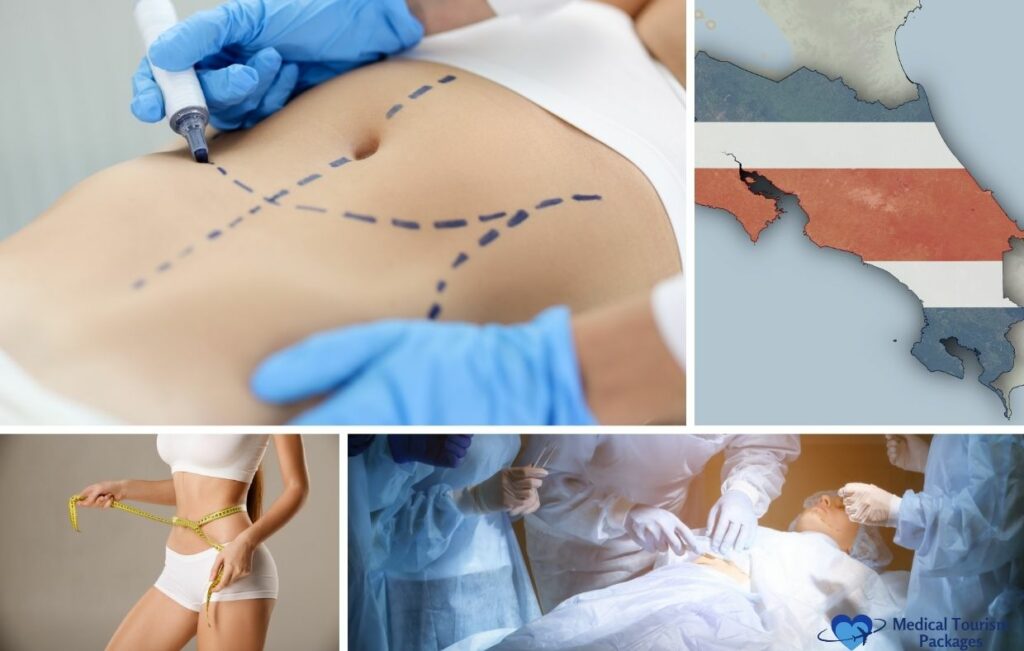
Abdominoplasty in Costa Rica: Complete Guide to Tummy Tuck Surgery, Costs, and Recovery
Costa Rica has become a leading destination for abdominoplasty, commonly known as tummy tuck surgery. This Central American country offers world-class medical facilities, board-certified plastic surgeons, and significant cost savings compared to procedures in North America and Europe.
Abdominoplasty removes excess skin and fat from the abdominal area while tightening weakened muscles. The procedure addresses concerns that diet and exercise cannot fix, including loose skin after pregnancy or major weight loss, separated abdominal muscles, and stubborn fat deposits.
Medical tourism in Costa Rica provides an attractive combination of quality care and affordability. Patients can save 40-60% on surgical costs while receiving treatment in JCI-accredited hospitals. The country’s proximity to the United States, stable healthcare system, and experienced surgeons make it an ideal choice for cosmetic surgery.
This guide covers everything you need to know about getting a tummy tuck in Costa Rica. You’ll learn about procedure types, costs, surgeon selection, recovery planning, and travel logistics. Whether you’re considering a mini tummy tuck or full abdominoplasty, this comprehensive resource will help you make an informed decision about your surgical journey.
What is Abdominoplasty Surgery in Costa Rica?
Abdominoplasty is a surgical procedure that removes excess skin and fat from the abdomen while tightening the underlying muscle wall. The surgery creates a flatter, more toned abdominal profile by addressing areas that cannot be improved through diet and exercise alone. Surgeons make an incision along the lower abdomen, remove unwanted tissue, and reposition the remaining skin for a smoother contour.
Costa Rica’s medical tourism industry has positioned the country as a premier destination for abdominoplasty procedures. The sector generates $437 million in annual revenue and employs over 10,000 healthcare professionals dedicated to international patients. This robust infrastructure ensures patients receive comprehensive care from consultation through recovery.
The market for cosmetic surgery in Costa Rica continues expanding rapidly. Industry projections show growth from $289 million in 2024 to $1.66 billion by 2033, reflecting increasing demand from international patients seeking quality procedures at competitive prices. This growth has driven investments in modern facilities, advanced surgical equipment, and specialized training for medical staff.
Why Do Patients Choose Costa Rica for Tummy Tuck Procedures?
Cost savings represent the primary driver for patients seeking abdominoplasty in Costa Rica. Patients typically save 50-70% compared to equivalent procedures in the United States, Canada, or Europe. A full tummy tuck that costs $8,000-$15,000 in North America can be performed for $3,000-$5,000 in Costa Rica, including hospital fees and surgeon costs. These savings allow patients to access high-quality surgical care while maintaining significant budget flexibility.
Costa Rica’s medical infrastructure ranks among the world’s most advanced for its size and economic level. The country holds 8th place globally in medical device exports, demonstrating its commitment to healthcare technology and innovation. Over 90 MedTech companies operate within Costa Rica, creating a competitive environment that drives continuous improvements in surgical equipment, techniques, and patient care standards.
Political stability and strong healthcare governance provide additional confidence for international patients. Costa Rica has maintained democratic stability for over 70 years and abolished its military in 1948, redirecting resources toward education and healthcare. The country’s geographic location offers practical advantages for North American patients, with direct flights from major U.S. cities taking 5-8 hours.
What Types of Tummy Tuck Surgeries Are Performed in Costa Rica?
Costa Rican plastic surgeons offer three primary abdominoplasty techniques to address different patient needs and anatomical concerns:
| Procedure Type | Description | Price Range | Key Features |
| Full Abdominoplasty | Comprehensive treatment from ribcage to pubic region with muscle repair and often liposuction | $4,000-$6,500 | Hip-to-hip incision Navel repositioning Diastasis recti correction 2-4 hour surgery |
| Mini Tummy Tuck | Focuses on lower abdomen below navel with minimal muscle work | $2,500+ | Shorter incision No navel repositioning 1-2 hour surgery Faster recovery |
| Extended Tummy Tuck | Addresses abdomen, flanks, and lower back for comprehensive contouring | $5,000-$7,000 | Circumferential improvement 46.7% combine with liposuction 4-6 hour surgery Ideal for massive weight loss patients |
How Much Does Abdominoplasty Cost in Costa Rica?
Abdominoplasty costs in Costa Rica range from $2,500 to $7,000, depending on the procedure type and complexity. These prices represent significant savings compared to North American and European markets while maintaining high surgical standards.
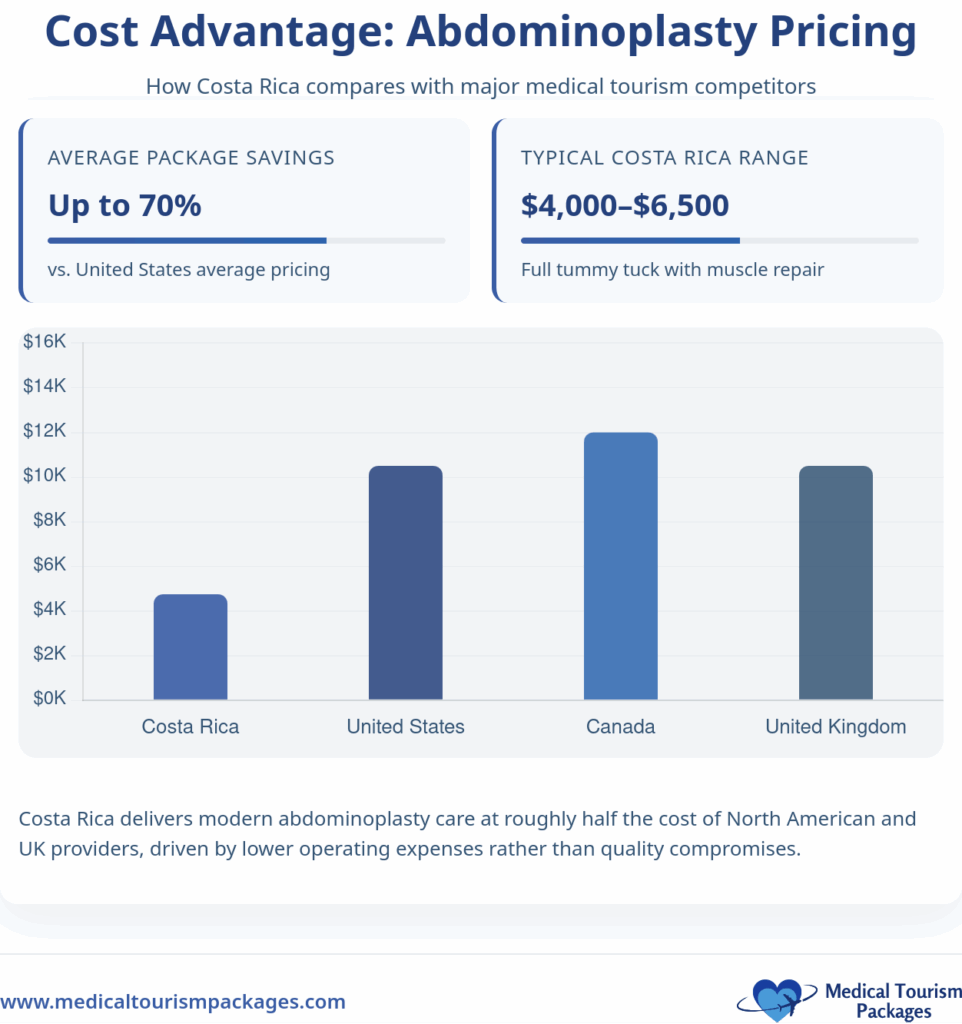
| Country | Price Range | Savings vs US |
| Costa Rica | $2,500-$7,000 | 50-70% |
| United States | $6,000-$15,000 | – |
| Canada | $9,000-$15,000 | 60-75% |
| United Kingdom | $10,500 | 65-75% |
What’s Typically Included in Costa Rica Packages
Most Costa Rican medical tourism providers offer comprehensive packages that include:
- Initial consultation with board-certified plastic surgeon
- Pre-surgery medical tests and laboratory work
- Surgeon and anesthesia fees for the procedure
- Hospital charges including operating room and recovery
- Airport transfers and local transportation
- Hotel accommodations with nursing support (all-inclusive packages)
Who is a Good Candidate for Tummy Tuck in Costa Rica?
Ideal candidates for abdominoplasty in Costa Rica are individuals in good overall health with realistic expectations about surgical outcomes. Statistics show that 93.3% of tummy tuck patients are women with a mean age of 42 years. Candidates should have stable weight for at least six months prior to surgery and be committed to maintaining their results through healthy lifestyle choices.
Body mass index plays a crucial role in determining surgical candidacy and safety. The mean BMI for tummy tuck patients is approximately 31.4, falling within the obese category but still considered acceptable for surgery by most plastic surgeons. However, patients with BMI ≥25 who undergo multiple combined procedures face higher complication risks including wound healing problems, infection, and blood clots.
Post-pregnancy women represent a large portion of abdominoplasty candidates, particularly those seeking “mommy makeover” procedures that combine tummy tucks with breast surgery. While these comprehensive procedures are popular in Costa Rica’s medical tourism market, they carry increased risks due to longer operative times and more extensive tissue manipulation. Women should wait at least six months after childbirth and complete breastfeeding before considering surgery.
How to Choose the Best Plastic Surgeon in Costa Rica?
Selecting a qualified plastic surgeon represents the most critical decision in your abdominoplasty journey. Costa Rica hosts many skilled surgeons, but patients must verify credentials carefully to ensure they receive safe, professional care.
Required Certifications and Qualifications
Legitimate plastic surgeons in Costa Rica must possess the following credentials:
- Affiliation with Colegio de Médicos y Cirujanos de Costa Rica (national medical licensing board)
- Specialized training from accredited US or European plastic surgery institutions
- Active membership in Costa Rican Association of Plastic Surgeons (ACCP)
- Board certification in plastic and reconstructive surgery from recognized international bodies
- Hospital privileges at accredited medical facilities
- Continuing education requirements and ongoing professional development
Patients should verify surgeon credentials directly through the Colegio de Médicos y Cirujanos de Costa Rica’s official database rather than relying on clinic websites or marketing materials. Be particularly cautious of surgeons who claim certification from “official-sounding boards” that may not be legitimate credentialing organizations. Request before-and-after photos, patient testimonials, and details about the surgeon’s experience with your specific type of abdominoplasty.
What Are the Steps to Getting Abdominoplasty in Costa Rica?
- Schedule Consultation – Contact your chosen clinic to arrange an initial consultation. Most established medical tourism facilities employ English-speaking staff to assist with scheduling and treatment planning.
- Complete Medical Tests – Undergo comprehensive pre-operative evaluations including blood work, electrocardiogram, chest X-rays, and physical examination. Some tests can be completed at home and sent to the Costa Rican facility.
- Plan Your Stay – Allocate minimum 2 weeks: 3 days in hospital, 5-10 days follow-up at recovery facility, and wait 12-14 days before flying to prevent blood clots.
- Prepare Documents – Gather valid passport and return ticket. US, Canadian, and EU citizens don’t need visas for stays up to 90 days. Bring medical records and travel insurance information.
How is Abdominoplasty Performed in Costa Rica?
Abdominoplasty ranks as the most commonly performed cosmetic procedure in Costa Rica, accounting for 36.6% of all plastic surgery cases. The surgical process begins with the patient under general anesthesia in a sterile operating room environment. The surgeon makes a horizontal incision along the lower abdomen, typically from hip to hip, positioned to remain hidden beneath underwear or bikini lines.
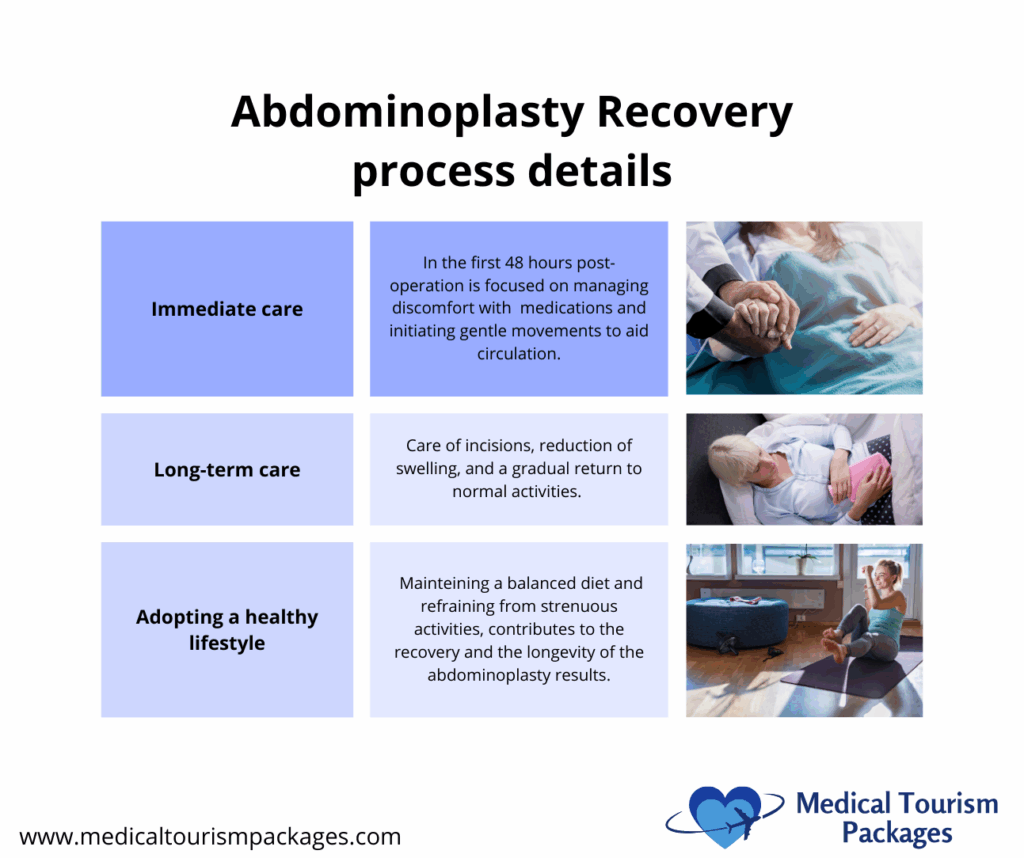
During the procedure, the surgeon separates the skin from the underlying abdominal muscles and removes excess fat and skin tissue. If muscle repair is needed, the surgeon sutures the separated rectus abdominis muscles back together to create a tighter abdominal wall. Surgery duration varies significantly based on procedure complexity – mini tummy tucks require 1-2 hours, full abdominoplasty takes 2-4 hours, and extended procedures can take 4-6 hours. General anesthesia remains the standard approach for all abdominoplasty procedures.
What is the Recovery Process After Tummy Tuck in Costa Rica?
The recovery timeline follows a predictable pattern with specific milestones:
| Time Period | Activity/Requirement | Details |
| Days 1-3 | Hospital Stay | Vital sign monitoring Pain management Compression garment fitting Initial mobility exercises |
| Days 4-10 | Recovery Facility | Professional nursing care Wound monitoring Drain removal (if applicable) Gradual activity increase |
| Days 5-10 | Follow-up Appointments | Incision assessment Progress evaluation Activity clearance Virtual options available |
| Days 12-14 | Travel Clearance | Medical approval to fly Final local check-up Care instructions for home |
| Weeks 6-8 | Major Swelling Resolution | Significant improvement visible Return to normal activities |
| Months 3-6 | Final Results | Complete swelling resolution Scar maturation begins |
Flight restrictions require patients to remain in Costa Rica for 12-14 days before returning home to prevent blood clot formation. Professional nurses at recovery facilities provide comprehensive pain management and wound care throughout the initial healing phase.
What Are the Best Hospitals and Clinics for Abdominoplasty in Costa Rica?
The highest-quality plastic surgery facilities are concentrated in San José and Escazú. Here’s a comparison of top facilities:
| Facility | Accreditation | Special Features | Location |
| Hospital CIMA | JCI-accredited | Baylor University affiliation Advanced surgical suites Emergency care available | San José |
| Clínica Bíblica | JCI-accredited | Comprehensive plastic surgery services International patient care program | San José |
| Hospital La Católica | JCI-accredited | Multilingual staff Modern equipment | San José |
| Costa Rica Medical Center Inn | Recovery Facility | 24-hour licensed nursing Concierge services Pool and spa amenities | Escazú |
| Las Cumbres Inn | Recovery Facility | Boutique setting Mountain location Personalized care | Escazú |
What Are the Risks and Complications of Tummy Tuck in Costa Rica?
Like all surgical procedures, abdominoplasty carries inherent risks that patients must understand before making treatment decisions.
Complication Rates and Types
- Major complications (severe infections, significant bleeding): ~1% of patients
- Mortality rate: 1 in 50,000 surgeries
- Common minor issues: Post-operative fever (5-10%), drainage from incisions, superficial wound infections
- Atypical infections: Risk of Nontuberculous Mycobacteria, requiring specialized antibiotics
- Other risks: Seroma, hematoma, delayed healing, unfavorable scarring, asymmetry, numbness
Emergency medical care in Costa Rica’s major cities meets international standards, but patients may encounter language barriers during crisis situations. Revision surgery needs can create logistical challenges for international patients, potentially requiring additional travel expenses. Travel insurance covering medical complications abroad becomes essential, though many policies exclude elective cosmetic procedures.
How to Prepare for Your Abdominoplasty Trip to Costa Rica?
Packing Checklist
Medical Items:
- Compression garments (multiple sizes)
- Current prescription medications
- Copies of medical records
- Post-op care supplies
Clothing:
- Loose-fitting, front-opening clothes
- Comfortable walking shoes
- Loungewear for recovery
Documents:
- Valid passport
- Return airline ticket
- Travel insurance information
- Emergency contacts
Medical Preparation:
- Schedule pre-surgery consultation with local physician
- Stop smoking 4+ weeks before surgery
- Avoid anti-inflammatory medications
- Maintain stable weight
- Arrange for travel companion if possible
Most recovery facilities provide comprehensive transportation including airport pickup, medical appointment transfers, and return airport service when cleared to travel.
What Results Can You Expect from Abdominoplasty in Costa Rica?
Initial results become visible immediately after surgery, but final outcomes emerge gradually as swelling subsides over several months. Most patients see significant improvement within 6-8 weeks when major swelling resolves, though minor swelling can persist for up to six months. The abdomen appears flatter and more contoured, with improved muscle tone and reduced skin laxity.
Results from abdominoplasty are considered permanent when patients maintain stable weight and healthy lifestyle habits. The removed skin and fat cannot return, and surgically tightened muscles retain their improved position indefinitely with proper care. However, natural aging processes, future pregnancies, or significant weight fluctuations can compromise surgical outcomes.
Scarring patterns from Costa Rican procedures are comparable to those performed in other countries, following standard surgical techniques. The main scar extends horizontally across the lower abdomen, positioned to remain hidden beneath underwear or swimwear. Most scars fade significantly over 12-18 months, progressing from red and raised to thin, pale lines.
What Financing Options Are Available for Tummy Tuck in Costa Rica?
| Payment Method | Details | Considerations |
| Credit Cards | Visa, MasterCard, AmEx accepted | May include processing fees |
| Wire Transfer | Direct bank transfer for large amounts | Check exchange rates |
| Cash (USD) | Accepted at most facilities | Carry securely |
| Medical Financing | Payment plans through clinics | Review interest rates and terms |
| Third-Party Loans | Specialized medical procedure loans | Compare multiple lenders |
Most international health insurance plans do not cover elective cosmetic procedures. However, insurance may cover emergency treatment if complications arise, though patients must pay directly and seek reimbursement later. Several established medical tourism facilities offer financing options with deposits required to secure surgery dates.
What Makes Costa Rica a Safe Destination for Medical Tourism?
Costa Rica maintains comprehensive regulatory oversight to ensure patient safety and quality care for international medical tourists.
Regulatory Oversight Structure
- Ministry of Health supervision – Direct oversight of all medical facilities and safety protocols
- New Law for Promotion and Development of Health Tourism Services – Comprehensive legislation for international patient care
- Inter-Institutional Commission members – Ministry of Health, ICT, and PROMED collaboration
Legal protections for international patients differ significantly from domestic healthcare systems. The U.S. State Department notes that malpractice options are limited compared to U.S. legal standards, making comprehensive travel insurance with medical evacuation coverage essential. Most established medical tourism clinics employ English-speaking staff, though nursing staff may have limited English proficiency, potentially creating communication barriers during recovery.
When is the Best Time to Schedule Abdominoplasty in Costa Rica?
Travel safety considerations should factor into your surgical timing decisions. The U.S. State Department maintains an “increased caution” advisory for Costa Rica due to crime rates, particularly in certain urban areas. While medical tourism facilities typically operate in safer districts with enhanced security measures, patients should stay informed about current conditions.
Regional health risks can impact surgical safety and recovery outcomes. The CDC issues periodic warnings for Central American countries regarding infectious disease outbreaks that could complicate post-operative healing. Check CDC travel health notices before finalizing surgery dates and consider seasonal patterns of disease transmission.
Individual patient risk factors should guide optimal timing. Patients planning multiple procedures face higher complication rates and require extended recovery periods. Those with elevated BMI levels need additional time for pre-operative preparation. Avoid scheduling surgery during stressful life events or major work commitments that could interfere with proper recovery.
Frequently asked questions
How much does a tummy tuck cost in Costa Rica?
Most abdominoplasty procedures cost $2,500–$7,000 depending on type and complexity: mini from ~$2,500, full ~$4,000–$6,500, extended ~$5,000–$7,000. Savings versus the U.S./Canada/Europe are typically 50–70% while using JCI-accredited hospitals and board-certified surgeons.
What tummy tuck types are available in Costa Rica?
Full abdominoplasty: Hip-to-hip incision, muscle repair, navel repositioning; 2–4 hours; ~$4,000–$6,500.
Mini tummy tuck: Targets lower abdomen below the navel, shorter incision, no navel move; 1–2 hours; from ~$2,500; faster recovery.
Extended tummy tuck: Addresses abdomen, flanks, and lower back; often combined with lipo; 4–6 hours; ~$5,000–$7,000; ideal after major weight loss.
What’s included in Costa Rica tummy tuck packages?
Typical packages include consultation, pre-op tests, surgeon and anesthesia fees, operating room and hospital recovery, airport transfers and local transport, and hotel or recovery-inn lodging (often with nursing support). All-inclusive options streamline logistics for international patients.
Who is a good candidate for a tummy tuck in Costa Rica?
Healthy adults with stable weight (≥6 months), realistic expectations, and concerns not fixable by diet/exercise. Mean patient age is ~42 and mean BMI ~31.4. Higher risks occur with BMI ≥25 when combining multiple procedures. Post-pregnancy patients should wait at least 6 months and complete breastfeeding before surgery.
How do I choose the best plastic surgeon in Costa Rica?
Verify: active license with the Colegio de Médicos y Cirujanos de Costa Rica, ACCP membership, accredited US/EU plastic surgery training, board certification in plastic & reconstructive surgery, privileges at accredited hospitals, and ongoing CME. Confirm via the official Colegio database; review before/after photos, case volume for your procedure, and authentic patient testimonials.
What is the recovery timeline and when can I fly home?
Days 1–3: hospital stay with monitoring and garment fitting. Days 4–10: recovery facility with nursing care; drain removal as needed. Days 5–10: follow-ups. Days 12–14: medical clearance to fly to reduce DVT risk. Weeks 6–8: major swelling subsides; months 3–6: final results and scar maturation begins.
What are the risks and complication rates?
Major complications occur in ~1% of cases; mortality is ~1 in 50,000. Minor issues include fever (5–10%), drainage, superficial infections; other risks are seroma, hematoma, delayed healing, unfavorable scars, asymmetry, and numbness. Rare atypical infections (e.g., NTM) may require specialized antibiotics. Consider travel insurance that covers complications and evacuation.
Which hospitals and recovery facilities are best?
Top choices are concentrated in San José and Escazú: Hospital CIMA (JCI; Baylor affiliation), Clínica Bíblica (JCI; international patient program), Hospital La Católica (JCI; multilingual staff). Recovery inns include Costa Rica Medical Center Inn (24/7 licensed nursing, concierge) and Las Cumbres Inn (boutique, personalized care).
What documents and prep do I need before traveling?
Bring a valid passport, return ticket (visa-free up to 90 days for US/CA/EU citizens), medical records, prescriptions, and travel insurance info. Stop smoking ≥4 weeks pre-op, avoid anti-inflammatories per surgeon guidance, maintain stable weight, and arrange a companion if possible. Plan at least a 2-week stay: hospital, recovery facility, and clearance to fly at days 12–14.

